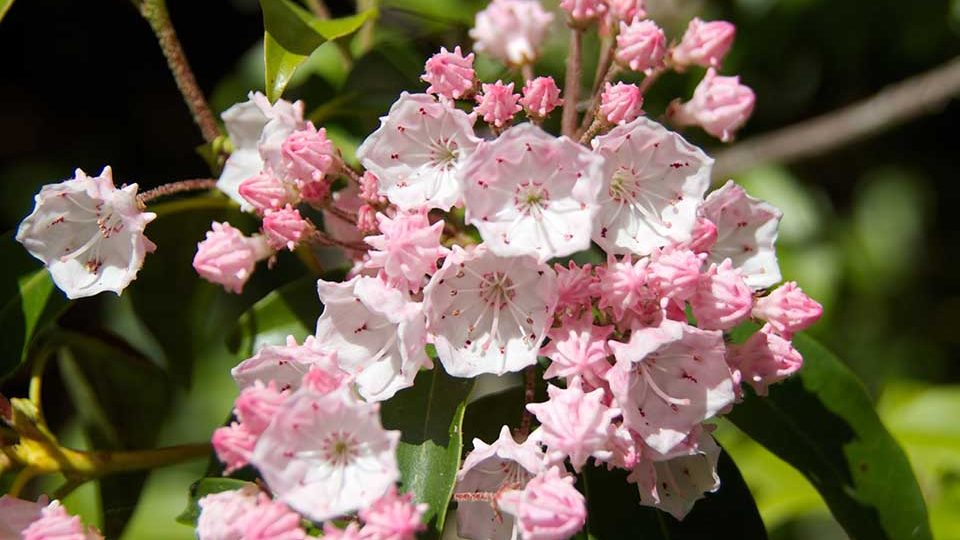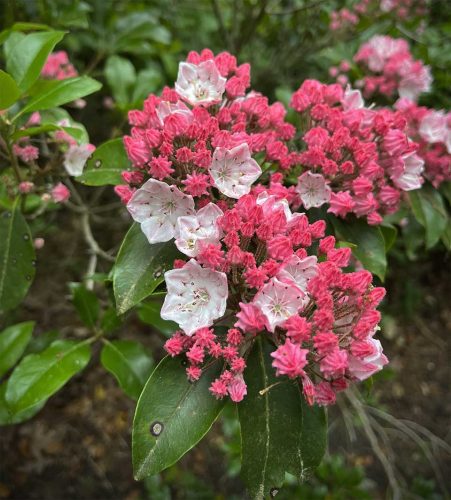Beauty To Behold
Mountain laurel is bursting with its annual show in our Pine Barren woodlands: Don’t miss the show!


One of the most spectacular regional shows in nature is about to commence now, in May. This is no ordinary “Yes, that is really pretty,” but rather a “Holy smokes, what an awesome display!” Over the coming couple of weeks our native mountain laurel will explode with splendor in our local forests, offering a free show with a phenomenal four-star rating.
The closed buds will start with a pink coloration and be shaped like a custard machine ice cream cone filling. Then the buds will burst forth into a nickel-sized bowl that gets whiter as it opens. The flower has five pointy petals with a stamen held tightly at the center and radiating outward.
The flowers seem impossibly attached by a central connection to the shrub, called a terminal flower cluster, or corymb. The clusters of blooms make a dramatic statement throughout the woodlands in its range. Residents of Connecticut and Pennsylvania are so taken by its beauty that they have declared it their state flower. (Our state flower here in New Jersey is the common blue violet, not so flashy but sweet.)
The flowers of mountain laurel are sensitive to the touch and their pollen anthers release when bees alight on them.
It is a great shrub for the yard but North Carolina extension warns that it is highly flammable and therefore should not be planted close to the house. There are many cultivars because it is so showy. It is said to be easily propagated from seed, so if you choose to plant it, seek a native variety.
Shrubs and Vines of New Jersey states “The shrub grows in sandy or rocky, acid or sterile soils of woods and edges; southeastern Maine to Georgia, west to Ontario, Indiana, Mississippi, western Florida and southeastern Louisiana.” It tolerates a wide range of light conditions from full sun to full shade but grows best in partial shade, doing well in sandy, drained soils and poorly in clay or wet soils. Therefore the acid sandy soils of our region’s coastal plain often provide ideal conditions.

The plant tends to grow slowly and achieve heights of six to 10 feet, forming thickets. On the slopes of the Appalachian Mountains it has been known to grow as tall as 32 feet (North Carolina State Extension). The branches of the shrub are gnarly and hard.
The shiny leathery green leaves and all parts of the plant are poisonous and responsible for some common names that I have never heard used—lambkill and calfkill. The scientific name Kalmia latifolia comes from Swedish botanist Peter Kalm and latifoli meaning wide-leaved. One source said it is known also as spoonwood, because Native Americans used it for utensils. Yet another common name—calico bush—derives from the tiny spots in the five-sided cup blossom.
Permit me to share a little side story. I awake one morning to the news a few months ago where a reporter is warning that hemlock is a deadly plant in our region. The news is pronounced with the impression that it has just become public enemy number one, with an urgency that this is newly found knowledge, as though children are grazing meadows and parents are casually serving it up at mealtimes. I think, “Whaaaat the dickens; if we get rid of all the poisonous plants we’ll need to nuke the planet.” Not a good way to start my day. Possibly they had just read of Socrates’ selected means of suicide or Shakespeare’s Hamlet. Please don’t tell a reporter that Connecticut’s and Pennsylvania’s state flower is poisonous or it may receive first billing on a wanted poster. And by the way our blue violet’s roots cause intestinal upset.
All that being said, in case you were planning on grazing on mountain laurel—don’t. This next section may sound a little like the end of television drug ads. Side effects may include the following, courtesy of North Carolina State Extension Service describing the high toxicity of mountain laurel: “[It] interferes with normal skeletal muscle, cardiac muscle, and nerve function. Clinical effects typically occur within a few hours after ingestion, and can include acute digestive upset, excessive drooling, loss of appetite, frequent bowel movements/diarrhea, colic, sweating, abdominal pain, depression, weakness, loss of coordination, stupor, watering of eyes and nose, nausea, cardiac failure, vomiting, leg paralysis, weak heart rate, and recumbency for two or more days; at this point, improvement may be seen or the animal may become comatose and die. Typically not very palatable to horses unless it is the only forage available, but sheep and goats may graze readily on the plant.” So basically it is not suitable for a livestock pen or foraging children (if that is a thing).

Native Americans did use Kalmia latifolia for medicinal purposes. Had they had television possibly they would have broadcast warnings of side effects, but instead they likely had shamans and common sense. Anyway the Cherokee are known to have used the leaves on scratches to ease soreness. Ten to 12 leaves were rubbed over the skin for rheumatoid arthritis and as a compound liniment for various cramps and pains. NaturalMedicalHerbs.net acknowledges its toxicity and goes on to discuss its uses as an “external” herbal remedy for skin diseases and inflammation. It adds, “The leaves are analgesic, astringent, disinfectant, narcotic, salve, and sedative.” WedMD suggests people have used it externally for ringworm, psoriasis, herpes and syphilis. These are all afflictions I hope never to have, but should they appear I’ll call my doctor and you should do the same.
The take-away is that mountain laurel is abundant in our Pine Barrens and it is a beauty to behold. It’s blooming over the coming weeks, mid-May into June, and you ought to get out and enjoy it!
Sources
Shrubs and Vines of New Jersey and the Mid-Atlantic States, NJ DEP Division of Parks and Forestry
Native American Ethnobotany, Daniel E. Moerman
North Carolina State Extension
Where To Behold
Places to see mountain laurel are numerous; here is a tiny sampling.Please send your favorite mountain laurel spots to our columnist at forrivers@comcast.net.
- • Bridgeton City Park
- • Mountain Laurel Trail, a three-mile loop Allaire State Park
- • Laurel Lake, Upper Lake area, Millville and Commercial Township
- • Estell Manor County Park, Mays Landing, Atlantic County
- •The Nature Conservancy’s Bluff Preserve, Silver Run Rd., Millville








